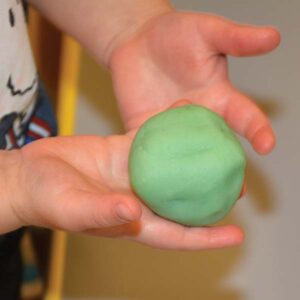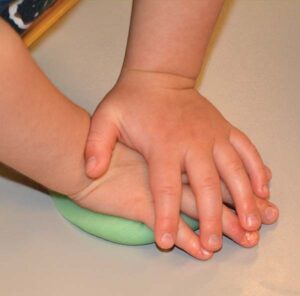Fine motor development
Toddlers explore ways to change a ball of play dough with finger and hand actions.



Be Prepared: Make one ball of play dough for each toddler, slightly larger than a toddler’s fist. Place the balls on a low table.
[Invite 2–4 toddlers to join you in working with play dough.]
 Each of us has a ball of dough to play with. Our dough is soft. There are many ways we can change our ball of dough by using our hands. Our fingers and hands can get strong playing with our dough!
Each of us has a ball of dough to play with. Our dough is soft. There are many ways we can change our ball of dough by using our hands. Our fingers and hands can get strong playing with our dough!
[Encourage toddlers to hold and touch the dough. Ask toddlers how the dough feels.
After a period for exploration, explain that we can have fun changing our dough with our hands. Suggest the following actions as toddlers’ interest and time permit:
 Squeeze the dough with two hands: Demonstrate picking up and holding the dough between both hands and then pushing on the dough with both hands. Explain that some toddlers like to call this squishing our dough. Invite toddlers to say the word squish.
Squeeze the dough with two hands: Demonstrate picking up and holding the dough between both hands and then pushing on the dough with both hands. Explain that some toddlers like to call this squishing our dough. Invite toddlers to say the word squish.Throughout the activity, emphasize how the dough changes when we move it with our hands. Example: “Look how our dough changed when we pushed down with two hands! Now the dough is flat.” Use action words, such as push and pull, to describe toddlers’ efforts.
Repeat and extend toddlers’ comments.
Bring the activity to a close by asking each toddler to squeeze all their play dough into one piece and pile it on top of yours in the middle of the table. Encourage toddlers to watch the play dough pile get bigger and bigger!]
We started with one ball of play dough. We changed the ball by squeezing, pushing, and pinching the dough. We pushed down on the ball and made it flat. We used our fingers and our whole hand to work the dough.
Play dough is an excellent material for helping toddlers increase their hand strength and dexterity. The flexible consistency of play dough makes it fun to explore. Toddlers are likely to differ in their interests in the manipulations suggested in the activity description. Some toddlers may prefer to focus on one action only, such as pinching off pieces of dough. It is fine for toddlers to be engaged in different actions with their dough.
At this age, toddlers are not expected to create a particular shape, such as a bird, with dough. Avoid suggesting toddlers make a specific type of object with their dough. Focus on explorations, not outcomes. Toddlers can become discouraged when adults present dough shapes that they are not able to produce.
Look for ways to support toddlers’ awareness of words that describe actions with the dough, as suggested in the activity description. Also, encourage toddlers to have fun manipulating the sounds of words. Many will enjoy saying squish!
Play dough is featured in a Block 6 activity (Physical/Health) with a primary focus on using both hands to flatten dough. The current activity suggests more ways to manipulate dough.
Extra support
Enrichment
Fine motor development
Toddlers make a creation of their own design with dough and several open-ended tools.



Be Prepared: Play dough that has been used a few times can be repurposed for this activity. Air dry dough recipes are available on the Internet. Provide one ball of dough per toddler. The suggested craft materials are open-ended tools that can be used in different ways with dough. Avoid providing cookie cutters or similar items that can limit creative use. Use a low table for the activity, with craft materials placed in the middle of the table.
Invite 2–4 toddlers to make a creation with play dough. Describe the air dry dough (“getting hard”) and other materials available, including different colors of markers. Explain that we can create whatever we want with our dough. Show how to use a craft stick to make a hole by pushing an end of the stick into the dough, and to make a line by pushing the stick’s side into the dough. Also show how a marker can be used to make marks, such as dots or lines or drawings on the dough. In addition, show how a thumb or finger can be used to make a hole in the dough. Use action words to describe your efforts, such as pushing a stick into dough. Explain that we can use different things for our creation (craft stick, markers, fingers).
Move around the table to interact with each toddler about his/her creation. Encourage toddlers to talk about what they are doing with their dough. Provide access to materials, including sharing specific colors of markers, as appropriate. You may wish to provide additional craft sticks if a toddler(s) wants to leave a stick(s) in their creation. Encourage toddlers to look at what their peers are doing.
Place each creation on a paper plate to dry overnight.
Toddlers enjoy pretend play with the dough and may give familiar labels to their shapes, such as house or animal. Encourage toddlers to create whatever they wish. Avoid offering a model. Emphasize how the craft materials can be used in different ways, such as making holes or lines with a craft stick, and different types and colors of marks with markers. The multi-use nature of these items, plus fingers, can support creativity to a greater extent than cookie cutters or similar items that are generally used in one way only.
A toddler may wish to engage in actions promoted in Option 1 but find them difficult to do in air dry dough. Use the experience as an opportunity to talk about soft and harder dough, and how air makes dough harder.
Some toddlers may enjoy playing with the dough but have little interest in making a creation to keep.
Extra support
Enrichment
Materials Needed: water, sand, sensory table, small toys, blocks, pegboards, puzzles, puffy salt paint (salt, flour, tempera paint), large bowl, squeeze bottles, paper
Add water to sand in the sensory table and encourage toddlers to scoop it, pat it down, and/or fill small containers. On another day, bury small toys in damp sand and encourage toddlers to find them by digging with their hands.
Also provide fit-together blocks, pegboards, and puzzles to encourage fine motor explorations.
For a creative activity, make Puffy Salt Paint. Mix equal parts of salt, flour, and a bit of tempera paint for color. In a large bowl, whisk small amounts of water into the flour/salt and paint mixture until it is the consistency of thick pancake batter. Fill squeeze bottles. Toddlers will enjoy using two hands to squeeze dots of puffy salt paint onto stiff paper. Make the puffy paint thick enough so that the toddlers will have an appropriate challenge squeezing the paint onto the paper.
Materials Needed: water mat, gel bag, tape, air dry clay, shoelace
In addition to offering Options 1 and/or 2 to toddlers, provide fine motor experiences for children of other ages. Mobile infants who do not use play dough will enjoy pushing down on a water mat (see Birth–12 Months, Block 12, Option 1, Cognitive). Pushing on a water mat will cause an object(s) in the mat to move. More than one infant can play with a water mat with you. You may also want to make your own gel bags for infants to use on a low surface, in a tub on the floor, or on a high chair tray. Put hair gel and a few very small items into a heavy, zip-type bag. Add color if you wish. Seal the bag with heavy tape. Attach the bag to a surface with strong, clear package tape.
Preschool-age and older children may enjoy Option 2. They also may enjoy making large beads from the air dry clay. Provide a shoelace for stringing the clay beads.